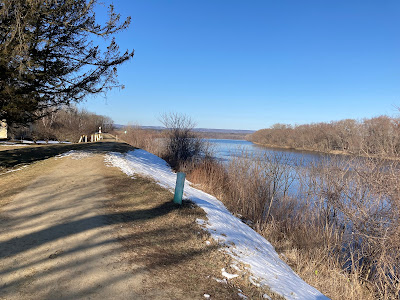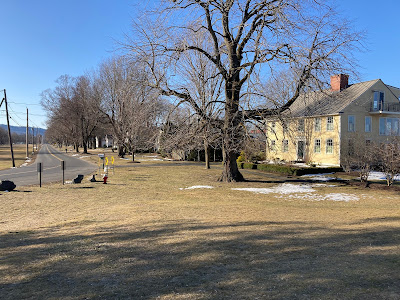Sorry Hadley - "He [Never] Left Behind His Sword"
The first town on the route of march of the British column after crossing to the east bank of the Connecticut River was Hadley, Massachusetts. Many of the British prisoners spent the nights of October 27th and 28th in Northampton, waiting for the weather to clear, and passed through or stopped in Hadley on the 29th. Others crossed over the river, arrived in the town October 31st, and spent the night.
Most of those who kept journals of the march paid little attention to the town. Massachusetts Militia Lieutenant Israel Bartlett would note: “[Oct.] 29 Wednsday. We are ordered to advance in front. We marched [from Northampton] and crossed the river at 10 o’clock, and advanced four miles from Hadley: place called Amherst.” Others, including Private David How stopped there: “[Oct.] 29 This Day we Crossed Coniticut River [from Northampton] and Staid at old Hadley At Night Its ben Wet marching” Most British entries were even briefer: "October … 29th. Crossed the Connecticut to Hadley 3 M[iles]", and a few days later more of the column arriving, the 47th Regiment noting: “Oct 31 Hadley miles [marched] 3.” [1]
One more myth (or simple mistake) regarding the Convention Army's passing through Hadley is an account of "Hessians" crossing the Connecticut River there. A 1906 history of the town makes the claim that: “Soon there was business at Joseph Kellog’s ferry, where a straggling army of Hessian mercenaries, prisoners of war, waited to be set [sic] over the river.”. In addition, it repeats the story of Burgoyne's sword with additional detail of it being "a three-edged rapier, with embossed silver handle and filigreed guard... on the blade near the handle the monogram G.R., while on the other side appears the coat of arms with the motto 'Honi soit qui mal y pense'." [6] While the author makes her claim regarding Burgoyne's sword based on personal observation, she offers no source for the claim that German prisoners from Saratoga crossed at Hadley. Perhaps however these were captives taken earlier at the Battle of Bennington.
Hadley is still a quiet town, set between its busier neighbors Northampton, to the west, and Amherst, to the east, and well worth a visit. Several buildings and sites dating from the time of the march of the Convention Army remain. The home occupied by Elizabeth Porter Phelps, built in 1752, is now the Porter-Phelps-Huntington House Museum. Today there is a hiking trail which runs along the river on the north end of the "extensive and spacious street parallel to the river" that Sergeant Lamb noted, West Street. To the south, off West Street, is the Old Hadley Cemetery (nicely described on the website "Lost New England") where a number of the town's early residents are buried. Bay Road, at the south end of West Street, is likely the route they took out of town, some to Amherst, some to Belchertown, all headed to the Upper Post Road in Brookfield, along which they would precede the German column for the remainder of the march.
[1] Bartlett, p. 402; How, p. 50; Napier, p. 329; 47th Regiment Journal, p. 157.
[2] Huntington, Arria, Under A Colonial Roof-Tree, Riverside Press, Cambridge, MA, 1891, p. 53; Pongratz, Simon, “Hadley’s Struggle for Independence'', on-line paper, p. 12.
[3] Lamb, Memoirs, p. 212.
[4] Huntington, Arria, Under A Colonial Roof-Tree, p. 53; Massachusetts Soldiers and Sailors of the Revolutionary War, Vol. 12, p. 587.
[5] Anburey, Vol. 2, pp. 37-38.
[6] Walker, Alice Morehouse, Historic Hadley, The Grafton Press, New York, NY, 1906, pp. 65-66.
Hadley resident Elizabeth Porter Phelps noted in her diary that on October 19th she heard the news the British had surrendered. Likely what she heard was news of the cease-fire that had been agreed to by American Major-General Horatio Gates and British Lieutenant-General John Burgoyne, and the negotiations that would lead to the Articles of Convention. Regardless, she was filled with joy, noting: “Oh wonderful, wonderful words cant express our adoration and praise! … I fall down in astonishment!” A week later, on October 26th (though no other sources support passage through Hadley on the 26th) she noted: “Our whole family Left home to see the Regulars pass, but only the babe and me.” [2]
Hadley was a prosperous Connecticut River Valley town, noted then and still for its fertile river valley farmland. British Sergeant Roger Lamb of the 9th Regiment of Foot recalled of his passing through:“Hadley was the first place we arrived at which had any local attractions to delight the eye. It is a pleasant town of Hampshire County, Massachusetts on the east of the Connecticut River. It then consisted of one extensive and spacious street parallel to the river.” [3]
A collection of tales regarding the town includes the story that Burgoyne gave Colonel Elisha Porter of Hadley a sword to thank him for his hospitality: "Esquire Porter, so often referred to, was a colonel in the Revolutionary War, and commanded troops in the campaign against Burgoyne. When his distinguished adversary passed through Hadley after his surrender, Colonel Porter invited him to stay at his house, while the soldiers encamped in the meadow. The courtesy was so generously appreciated by the British officer that he left behind his sword as a recognition of the hospitality extended to him. This memento, which is of beautiful workmanship, is treasured among his descendants to the present time." Though Porter was a colonel, and commanded the 4th Hampshire County Regiment of the Massachusetts Militia, which marched on September 24, 1777, to reinforce the Northern Army and served until October 17, 1777, Brigadier-General William Whipple’s Journal indicates Burgoyne did not pass through Hadley. [4]
If Burgoyne didn't stop in Hadley (or Northampton), what may have led its residents think that he did? Perhaps the source of these tales is explained by British Ensign (and author) Thomas Anburey. According to Anburey, at some point along the march one of the officers with the British column went on ahead, and claimed to be Burgoyne in order to get better quarters. Being the first to reach "a small village, he personated General Burgoyne, and with such an air of confidence..." that his hosts being "compleatly outwitted, they assigned him the best quarters." [5]
A collection of tales regarding the town includes the story that Burgoyne gave Colonel Elisha Porter of Hadley a sword to thank him for his hospitality: "Esquire Porter, so often referred to, was a colonel in the Revolutionary War, and commanded troops in the campaign against Burgoyne. When his distinguished adversary passed through Hadley after his surrender, Colonel Porter invited him to stay at his house, while the soldiers encamped in the meadow. The courtesy was so generously appreciated by the British officer that he left behind his sword as a recognition of the hospitality extended to him. This memento, which is of beautiful workmanship, is treasured among his descendants to the present time." Though Porter was a colonel, and commanded the 4th Hampshire County Regiment of the Massachusetts Militia, which marched on September 24, 1777, to reinforce the Northern Army and served until October 17, 1777, Brigadier-General William Whipple’s Journal indicates Burgoyne did not pass through Hadley. [4]
If Burgoyne didn't stop in Hadley (or Northampton), what may have led its residents think that he did? Perhaps the source of these tales is explained by British Ensign (and author) Thomas Anburey. According to Anburey, at some point along the march one of the officers with the British column went on ahead, and claimed to be Burgoyne in order to get better quarters. Being the first to reach "a small village, he personated General Burgoyne, and with such an air of confidence..." that his hosts being "compleatly outwitted, they assigned him the best quarters." [5]
One more myth (or simple mistake) regarding the Convention Army's passing through Hadley is an account of "Hessians" crossing the Connecticut River there. A 1906 history of the town makes the claim that: “Soon there was business at Joseph Kellog’s ferry, where a straggling army of Hessian mercenaries, prisoners of war, waited to be set [sic] over the river.”. In addition, it repeats the story of Burgoyne's sword with additional detail of it being "a three-edged rapier, with embossed silver handle and filigreed guard... on the blade near the handle the monogram G.R., while on the other side appears the coat of arms with the motto 'Honi soit qui mal y pense'." [6] While the author makes her claim regarding Burgoyne's sword based on personal observation, she offers no source for the claim that German prisoners from Saratoga crossed at Hadley. Perhaps however these were captives taken earlier at the Battle of Bennington.
Hadley is still a quiet town, set between its busier neighbors Northampton, to the west, and Amherst, to the east, and well worth a visit. Several buildings and sites dating from the time of the march of the Convention Army remain. The home occupied by Elizabeth Porter Phelps, built in 1752, is now the Porter-Phelps-Huntington House Museum. Today there is a hiking trail which runs along the river on the north end of the "extensive and spacious street parallel to the river" that Sergeant Lamb noted, West Street. To the south, off West Street, is the Old Hadley Cemetery (nicely described on the website "Lost New England") where a number of the town's early residents are buried. Bay Road, at the south end of West Street, is likely the route they took out of town, some to Amherst, some to Belchertown, all headed to the Upper Post Road in Brookfield, along which they would precede the German column for the remainder of the march.
[1] Bartlett, p. 402; How, p. 50; Napier, p. 329; 47th Regiment Journal, p. 157.
[2] Huntington, Arria, Under A Colonial Roof-Tree, Riverside Press, Cambridge, MA, 1891, p. 53; Pongratz, Simon, “Hadley’s Struggle for Independence'', on-line paper, p. 12.
[3] Lamb, Memoirs, p. 212.
[4] Huntington, Arria, Under A Colonial Roof-Tree, p. 53; Massachusetts Soldiers and Sailors of the Revolutionary War, Vol. 12, p. 587.
[5] Anburey, Vol. 2, pp. 37-38.
[6] Walker, Alice Morehouse, Historic Hadley, The Grafton Press, New York, NY, 1906, pp. 65-66.
For more on the Convention Army's 1777 march from Saratoga to Boston, see:





Comments
Post a Comment